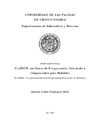Identificador persistente para citar o vincular este elemento:
https://accedacris.ulpgc.es/handle/10553/5013
| Campo DC | Valor | idioma |
|---|---|---|
| dc.contributor.advisor | Cabrera Gámez, Jorge | - |
| dc.contributor.advisor | Hernández Tejera, Francisco Mario | - |
| dc.contributor.author | Domínguez-Brito, Antonio C. | - |
| dc.contributor.other | Cabrera-Gamez, Jorge | - |
| dc.contributor.other | Dominguez Brito, Antonio Carlos | - |
| dc.creator | Domínguez Brito, Antonio Carlos | es |
| dc.date | 2003-09-25T02:31:00Z | es |
| dc.date.accessioned | 2011-03-28T02:31:00Z | - |
| dc.date.accessioned | 2018-06-05T13:20:38Z | - |
| dc.date.available | 2011-03-28T07:48:37Z | - |
| dc.date.available | 2018-06-05T13:20:38Z | - |
| dc.date.issued | 2002 | en_US |
| dc.identifier.isbn | 3-540-43399-6 | en_US |
| dc.identifier.issn | 0302-9743 | - |
| dc.identifier.uri | https://accedacris.ulpgc.es/handle/10553/5013 | - |
| dc.description.abstract | Programming software for controlling robotic systems in order to built working systems that perform adequately according to their design requirements remains being a task that requires an important development effort. Currently, there are no clear programming paradigms for programming robotic systems, and the programming techniques which are of common use today are not adequate to deal with the complexity associated with these systems. The work presented in this document describes a programming tool, concretely a framework, that must be considered as a first step to devise a tool for dealing with the complexity present in robotics systems. In this framework the software that controls a system is viewed as a dynamic network of units of execution inter-connected by means of data paths. Each one of these units of execution, called a component, is a port automaton which provides a given functionality, hidden behind an external interface specifying clearly which data it needs and which data it produces. Components, once defined and built, may be instantiated, integrated and used as many times as needed in other systems. The framework provides the infrastructure necessary to support this concept for components and the inter communication between them by means of data paths (port connections) which can be established and de-established dynamically. Moreover, and considering that the more robust components that conform a system are, the more robust the system is, the framework provides the necessary infrastructure to control and monitor the components than integrate a system at any given instant of time. | en_US |
| dc.language | eng | en_US |
| dc.relation.ispartof | Lecture Notes in Computer Science | es-ES |
| dc.source | Sensor Based Intelligent Robots[ISSN 0302-9743],v. 2238, p. 282-304, (2002) | - |
| dc.subject | 1203 Ciencia de los ordenadores | en_US |
| dc.subject | 3304 Tecnología de los ordenadores | en_US |
| dc.subject | 120703 Cibernética | en_US |
| dc.subject.other | Robótica | en_US |
| dc.subject.other | Componentes Software | en_US |
| dc.subject.other | Integración de Sistemas | en_US |
| dc.subject.other | Ingeniería del Software | en_US |
| dc.title | CoolBOT: a component-oriented programming framework for robotics | en_US |
| dc.type | info:eu-repo/semantics/Article | en_US |
| dc.type | Article | en_US |
| dc.type | Thesis | en_US |
| dc.type | Thesis | en_US |
| dc.type | Thesis | en_US |
| dc.relation.conference | 4th International Workshop on Modeling and Integration of Sensor Based Intelligent Robot Systems | - |
| dc.identifier.isi | 000189444000016 | - |
| dcterms.isPartOf | Sensor Based Intelligent Robots | - |
| dcterms.source | Sensor Based Intelligent Robots [ISSN 0302-9743], v. 2238, p. 282-304 | - |
| dc.compliance.driver | 1 | es |
| dc.fechadeposito | 2011-03-28T07:48:37Z | es |
| dc.identifier.absysnet | 625260 | - |
| dc.description.firstpage | 304 | - |
| dc.relation.volume | 2238 | - |
| dc.investigacion | Ingeniería y Arquitectura | en_US |
| dc.rights.accessrights | info:eu-repo/semantics/openAccess | es |
| dc.type2 | Artículo | en_US |
| dc.identifier.wos | WOS:000189444000016 | - |
| dc.contributor.daisngid | 7237098 | - |
| dc.contributor.daisngid | 2400693 | - |
| dc.contributor.daisngid | 10298839 | - |
| dc.identifier.investigatorRID | H-7722-2015 | - |
| dc.identifier.investigatorRID | K-9592-2013 | - |
| dc.utils.revision | Sí | en_US |
| dc.contributor.wosstandard | WOS:Cabrera-Gamez, J | - |
| dc.contributor.wosstandard | WOS:Dominguez-Brito, AC | - |
| dc.contributor.wosstandard | WOS:Hernandez-Sosa, D | - |
| dc.date.coverdate | 2002 | - |
| dc.identifier.conferenceid | events120392 | - |
| dc.identifier.ulpgc | Sí | es |
| dc.description.jcr | 0,515 | |
| dc.description.jcrq | Q3 | |
| item.grantfulltext | open | - |
| item.fulltext | Con texto completo | - |
| crisitem.event.eventsstartdate | 15-10-2000 | - |
| crisitem.event.eventsenddate | 20-10-2000 | - |
| crisitem.author.dept | GIR SIANI: Inteligencia Artificial, Robótica y Oceanografía Computacional | - |
| crisitem.author.dept | IU Sistemas Inteligentes y Aplicaciones Numéricas | - |
| crisitem.author.dept | Departamento de Informática y Sistemas | - |
| crisitem.author.orcid | 0000-0002-0260-4524 | - |
| crisitem.author.parentorg | IU Sistemas Inteligentes y Aplicaciones Numéricas | - |
| crisitem.author.fullName | Cabrera Gámez, Jorge | - |
| crisitem.advisor.dept | GIR SIANI: Inteligencia Artificial, Robótica y Oceanografía Computacional | - |
| crisitem.advisor.dept | IU Sistemas Inteligentes y Aplicaciones Numéricas | - |
| crisitem.advisor.dept | Departamento de Informática y Sistemas | - |
| crisitem.advisor.dept | GIR SIANI: Inteligencia Artificial, Redes Neuronales, Aprendizaje Automático e Ingeniería de Datos | - |
| crisitem.advisor.dept | IU Sistemas Inteligentes y Aplicaciones Numéricas | - |
| crisitem.advisor.dept | Departamento de Informática y Sistemas | - |
| Colección: | Tesis doctoral | |
Citas de WEB OF SCIENCETM
Citations
2
actualizado el 25-feb-2024
Visitas
274
actualizado el 31-may-2025
Descargas
343
actualizado el 31-may-2025
Google ScholarTM
Verifica
Altmetric
Comparte
Exporta metadatos
Este elemento está sujeto a una licencia Licencia Creative Commons

